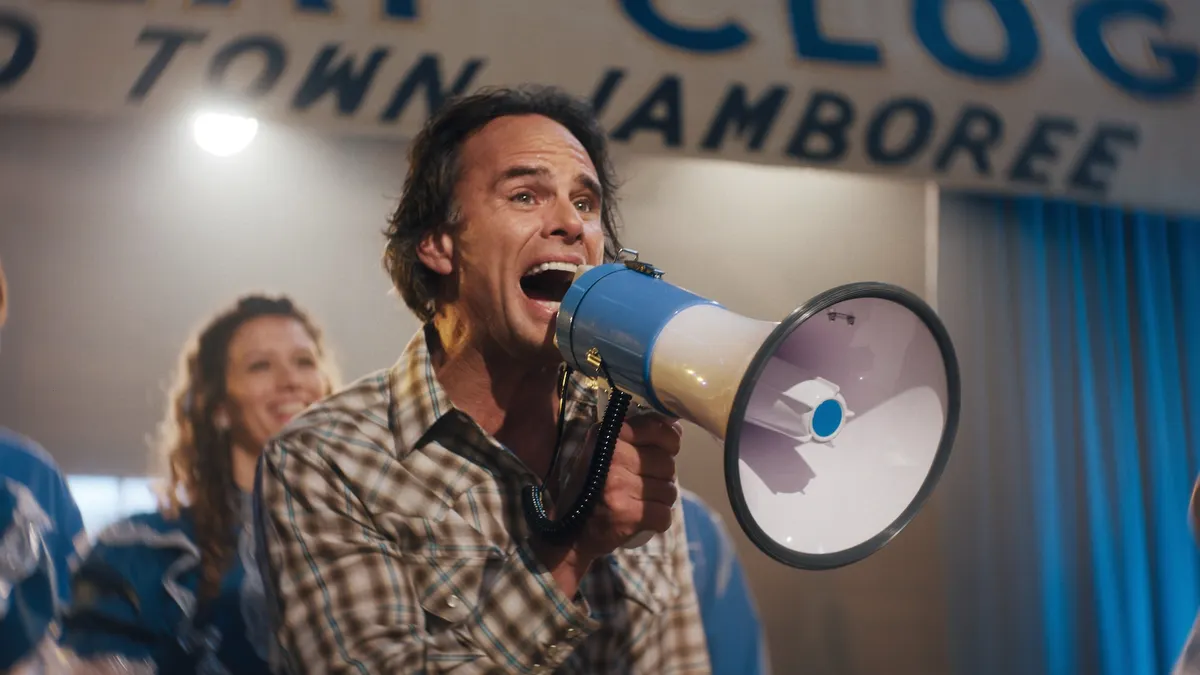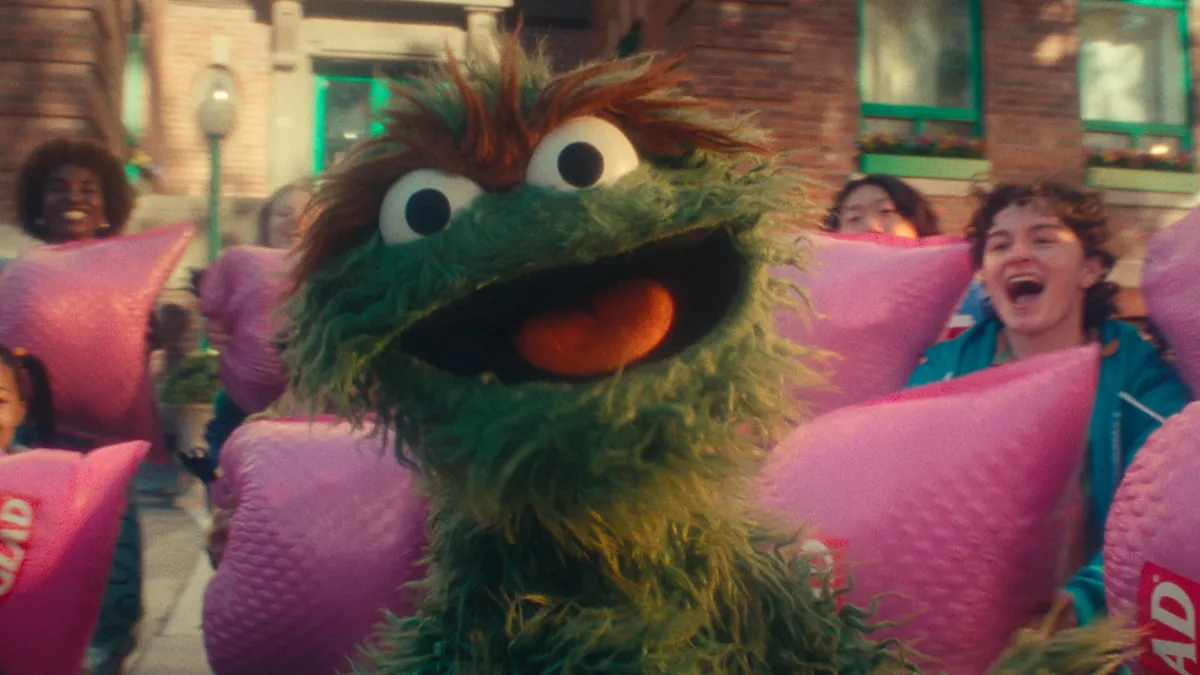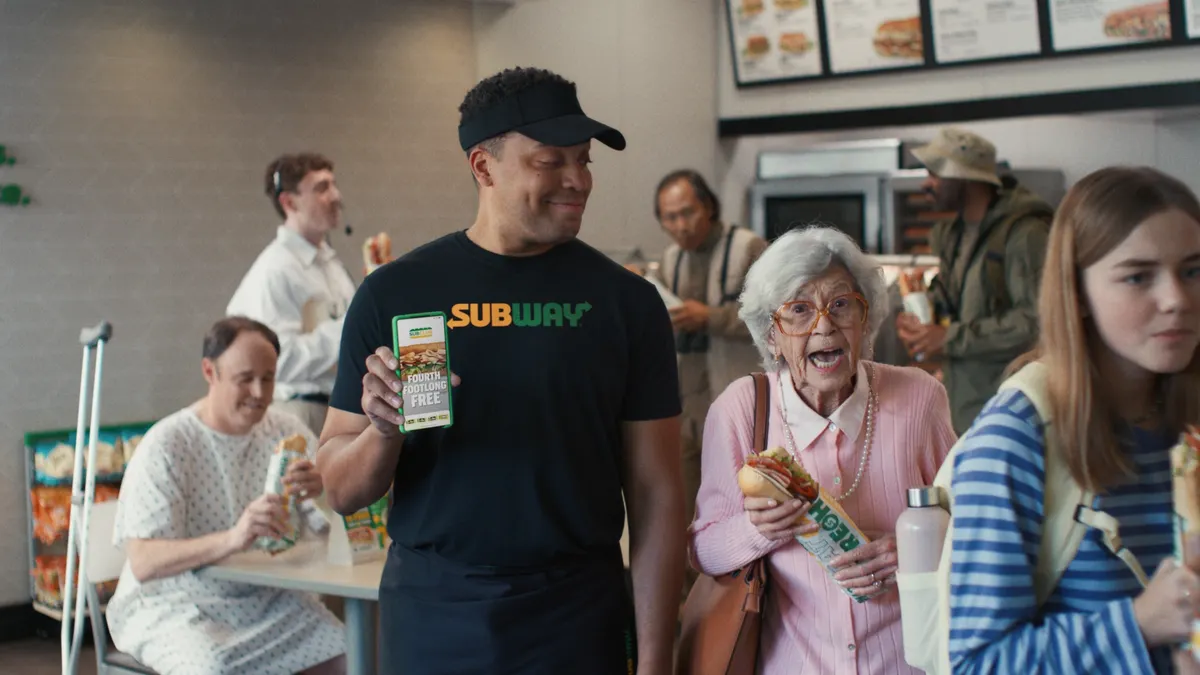The New England Patriots may have pulled off a late-game rally to best the Los Angeles Rams for Super Bowl LIII and win their sixth championship in 18 seasons, but viewers looking for clear-cut brand winners likely struggled to come up with strong picks. For a big game that's broadly been deemed one of the most boring in recent memory, if not ever — and marks the lowest-scoring Super Bowl in history, and one that hit a 10-year ratings low — there was no "It's a Tide ad" touchdown moment that immediately captured fan interest and laughs for the off-the-field action.
"Unfortunately, we were served a body of work that was generally disappointing, replete with '90s celebs, hyperbole and gimmicks over stories," Michelle Edelman, chief strategy officer at Peter Mayer Advertising, New Orleans, commented to Marketing Dive.
There were certainly some dominant players on Sunday night, according to social media analytics from Talkwalker. AB InBev ran a slew of ads for brands like spiked sparkling water line Bon & Viv, Michelob Ultra and Bud Light, the last of which shocked viewers and scored online conversation by tying up with HBO's "Game of Thrones." PepsiCo curried favor by leaning into humor and trotting out a cadre of famous faces, including the Backstreet Boys and Chance the Rapper for Doritos and Steve Carell, Cardi B and Lil Jon for its namesake soft drink brand. Some spots left people scratching their heads, in ways both good — think resurrected Andy Warhol footage for Burger King's #EatLikeAndy — and bad, like the baffling, creepy TurboTax robot baby. On the purpose side of things, ads targeted at women seemed to play well by leaning into humor (Olay), empowerment (Bumble) or tapping into modern American anxieties (Hulu's "The Handmaid's Tale").
But for the most part, brands kept messaging apolitical and close to the chest, which might've ultimately left fans hankering for more edge or even some controversy that could better reflect the divided cultural climate. A few sprinklings of mobile integrations, like Expensify touting its QR code scanning or Audible promoting a tie-in with Alexa, also didn't bring a strong enough digital variety to a slate of commercials that featured a surprising amount of purely product-focused creative; or in other words, creative that didn't really feel like Super Bowl ads at all, which resulted in some of the most interesting marketing around the game not even appearing on TV.
"We are in a uniquely unsettled, divisive and fragile moment in time — culturally, politically and economically. In years past, the mood of the country was different and the battle for attention and post-game buzz led to more expansive and more playful forms of disruption," Jay Suhr, chief creative officer at the agency T3, told Marketing Dive in emailed comments. "I was interested in seeing how brands and agencies would play things in 2019. The answer: they played it safe."
AB InBev conquers — but not everything's a hit
AB InBev still captured a lot of interest by railing on competitors for their of use of corn syrup, tapping into some serious "Game of Thrones" carnage with HBO and also arguably by sheer force of will, with more than five minutes of total Super Bowl air time across its brands.
Among marketers and agency execs, the "Game of Thrones" ad earned the crowning achievement for the night thanks to savvy pop culture references and a continuation of Bud Light's winning "Dilly Dilly" medieval storyline. Created with Wieden + Kennedy for Bud Light and Droga5 for HBO, the 60-second "Joust" also netted the Super Clio trophy for best Super Bowl ad, per details shared with Marketing Dive.
"That integration was a big win because it stood out from the crowd and the ad recall will be very high," Benjamin Hordell, partner at DXagency, said in comments to Marketing Dive. "There is no confusion as to what show it was or which beer."
While "Game of Thrones" might've provided a cherry on top for the brewing giant, other efforts felt like a tonal mismatch with the marquee spot, according to several executives sharing their thoughts with Marketing Dive. Some were confused as to why AB InBev decided to harp on competitor MillerCoors for using corn syrup as an ingredient, which some argued isn't a big issue for casual beer drinkers.
"It just doesn't seem authentic to their core brands, and mixed in with the zany approach of their typical entertaining spots, it felt even more contrived," Travis York, CEO of GYK Antler, told Marketing Dive.
Less easy to categorize and probably too niche for the Super Bowl crowd was a spot for Michelob Ultra Pure Gold starring Zoe Kravitz that tapped into the online trend of autonomous sensory meridian response (ASMR) videos that look to induce tingling sensations in viewers.
"We're in love with ASMR videos on YouTube, so why not try it in a TV spot, right?" Peter Mayer Advertising's Edelman said. She felt the ad felt flat due to generic "organic" and sensory-based messaging that's hard for one brand to own.
"We weren't sure exactly what the main message was intended, but the combination of techniques left us not really remembering anything strongly enough," she added.
Pepsi shakes up mixed responses
Like AB InBev, PepsiCo put a heavy push behind a number of products, including a new extra-hot Doritos flavor and its nascent sparkling water brand Bubly. In terms of winners for the food and beverage maker, however a celeb-studded "More than OK" ad that riffs on consumers' frequent preference for Coke soared the highest and smartly played into the fact that the big game was being hosted in its main rival's hometown of Atlanta.
"The brand utilized a smart campaign, star power, social media integration and, of course, the halftime show to own the night," DXagency's Hordell said.
At the same time, others thought the 60-second spot's tone of depreciation went a little too far.
"'Is Pepsi OK?' is a generic substitute for 'is the product you truly want OK?,'" Michael Sharp, CEO and co-founder at Standard Black, told Marketing Dive. "Pretty much never, and it's surprising this insight made it all the way to the Super Bowl — to verify Coke's place in most people's mind."
The Super Bowl also set the stage for Bubly to make an impact and stand out in an increasingly crowded field of competitors, including La Croix and alcoholic varieties like AB InBev's Bon & Viv — also a first-time Super Bowl advertiser. As a sheer brand recognition play, it's possible that Bubly could take home the win.
"Not only did the brand manage to put a smile on our faces … it managed to say the brand's name [and] riffed off the celebrity's name 10 times in 30 seconds and [showed] the product in nearly every shot," Edelman said.
A robot-led future
A unifying theme across a few brands' ads was also conceptualizing how robots and AI are taking over the world, though messaging often tended to lean toward humor versus dystopian doom and gloom. Michelob Ultra was able to win back some positive sentiment with a spot that depicted all of the things that robots can do better athletically than humans — and the one thing that they can't, which is enjoy a beer after a tough workout.
"While initially, it looked like a sinister message ... I was pleasantly surprised at the end with the robot looking longingly at the bar," Ty Shay, CMO of Norton LifeLock, said in comments to Marketing Dive. "This was also a great example of blending consumer insights about why we exercise as part of the storyline."
Amazon also appeared to continue a winning streak it started last year by imagining failed Alexa products, like a toothbrush that plays podcasts or a voice-activated dog collar. Though the spot maybe wasn't quite as buzzy as the Super Bowl ad the online retailing giant ran last year, which included a cameo from CEO Jeff Bezos, it still hit its big marks.
"It's a pretty dead-on brand message from a company that wants to appear likeable and approachable while at the same time assert its unquestionable global dominance," Ted Jendrysik, creative director at Mechanica, told Marketing Dive.
One offering that seemed to stoke strong negative reactions across the board came from TurboTax, which offered the depiction of a "RoboChild" that horrifically malfunctions once it learns that it can never be one of the brand's live CPAs. The key words most associated with the misfire were "creeped," "creepy," "tax" and "government," according to Crimson Hexagon data shared with Marketing Dive.
Female-targeted ads sing, while retrograde humor falls flat
Major marketers have spent the last few years making their ads more gender-inclusive and stereotype-free, and the Super Bowl this year presented an opportunity to continue these initiatives on a historically male-focused platform. While the Super Bowl offering avoided hot button issues like the #MeToo movement — perhaps in an effort to avoid the type of backlash that Gillette faced — ads starring women and focused on female audiences did catch audience's attention, such as those for Bumble.
"I thought [Serena Williams] was a strong spokesperson to carry the message that women should make that first move. And the message itself couldn't be more timely," said Sandi Harari, creative director at Barker, of the Bumble ad. "The backstory of it being fully female made wasn't a bad move either. I don't care if it's self serving — it was still an all-woman-created ad and I have to applaud that."
Even ads that didn't have a socio-political focus were able to introduce non-traditional Super Bowl brands with a unique spin, like Olay's horror movie-parody starring erstwhile scream queen Sarah Michelle Gellar.
"Sarah Michelle Gellar and Olay changed the tone of the skincare category," said Daniel Lobatón, creative director at Saatchi & Saatchi New York. "This was the bravest move." Similarly, its placement during the Super Bowl was described as "groundbreaking... odd and unexpected" by R2C Group CCO Steve Diamond.
However, ads that stuck to old stereotypes and approaches failed to move the needle, especially Devour's "food porn" ad, which made pre-Bowl headlines for its placement on an actual porn site.
"Devour Frozen Food wins the prize for most unfunny, cringe-worthy innuendos in thirty seconds," said Deutsch CCO Dan Kelleher.
Plus, it offended in perhaps an unintended fashion.
"This country is in the middle of an opioid epidemic. Addiction isn't really something to have fun with," said Samira Ansari, group creative director of Johannes Leonardo.
Too many brands throw incompletions
Devour wasn't the only brand to shrink in the spotlight on game day, for a variety of reasons. Many brands were able to score early buzz with pre-game teasers — like Stella Artois' did with its ad featuring Carrie Bradshaw and The Dude — but spoiled the surprise when the ad actually aired.
"Too many ads were released before the night and I figured I'd already seen this one and switched off," said Ansari.
As in football, sometimes a Hail Mary is intercepted. That was the case with one of the night's least loved spots, Mint Mobile's stomach-churning "Chunky-Style Milk? That's Not Right" ad.
"This is your chance to introduce your brand to the world and you do it with spoiled milk," said Kelly Bayett, creative director and partner Barking Owl. "The idea wasn't big or outrageous enough to be funny. It was just gross and it didn't make people want to know more."
Perhaps the lesson marketers can learn from this year's Super Bowl, where both the teams and brands played it too safe to leave a lasting impression, is to look for more innovation off the field.
"The most exciting brand plays of Super Bowl LIII have occurred off of the television," said Rigel Cable, associate director of data analytics for Astound Commerce. "In Atlanta, brands like Adidas, Maxim and BET have created a world around the Super Bowl, attracting major celebrities and the attention of social media. As the media landscape changes, these are the activations that I am watching."




















